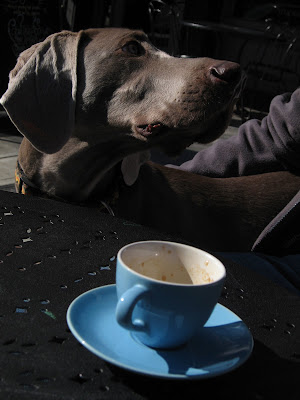
Let's follow up on Dave the Dog's coffee break.
As we saw earlier, the high contrast setting with the super bright sidewalk, the dark black metal table and the deep shadows under the storefront awnings sent the light meter in my little point & shoot a little crazy. I did not like the pictures. On the camera that I have (an older Canon PowerShot 550SD), there is limited manual capability, so I set the camera to automatically under expose one stop.
For the first image, the camera chose a 250th shutter speed at f/stop 7.1. This is almost the exposure that the camera picked for the first fully auto shot (1/200 at 7.1; the second fully auto frame was shot at 1/500 at 2.8). The next one was also 250th at 7.1 f/stop, though the second one came out a little darker. At -1.00 exposure compensation, the camera also shot a frame at 1/400th at 3.5 f/stop. Don't know why.
In the camera LCD screen, the pictures still looked to light. So I set the exposure compensation to -2.00, or two stops under exposed. It shot at 1/320th at 9.0 f/stop. Oops - too dark. And what kind of a setting selection is that? (But wow, what a face!)
I then set the camera to shoot at -0.67. (check for 'exposure compensation' in your camera manual. This is done in-camera, and it might also be possible to set it for your flash.) The fourth pic shot at /125th at 7.1 f/stop. Now that is a FULL stop over exposed as compared to the first auto-exposure, which was 250th at 7.1. Hmmm. It is set to under expose. The camera also made a frame at 1/160th and 7.1 f/stop. Okay ... this little point & shoot is wigging out in this contrasty situation.
So what do we take from this? Well, I was quite surprised at how the exposure settings in this point & shoot bounced around so much. It also told me not to get to upset with, or invested in, photos that this particular camera can make in difficult light. Under better conditions, it makes beautiful images. But it definitely has its limits, as do most point & shoot cameras. Know your equipment, however simple or advanced it is. And read the owners manual so that you know all of the ins and outs of what it CAN do.
Also -- take note where the camera is aimed to take its exposure readings. Is it reading mostly off of the dark table or the bright sidewalk? Is there a balance of dark, light and midtones for the light meter to read from? This was not only a high contrast situation, it was high contrast with primarily black, white, deep shadows and a guy in a gray sweatshirt with a cap that covered his eyes. Thank the photo gods for a blue ceramic cup. A more colorful scene with a range textures and reflective surfaces might not have been so difficult.
And -- while taking these types of pictures, watch your subject. You can see that as Dave moves his head around, those big floppy ears can shadow his eyes. Or a slight look down to the table will shadow his eyes. When he looked up, his face was all nicely and somewhat evenly exposed by the sun. Just under exposed by me. Oh well.
The highlights under the awning are interesting to note. The neon sign, the reflecting edges of the chairs, and the red jacket. With more work, this could be nicely composed.
One more thing. That -2.00 under exposed shot of Dave that I liked best (what a face) lightened up pretty well in Photoshop. All was not lost.
Here's to almost Spring,
Robin





